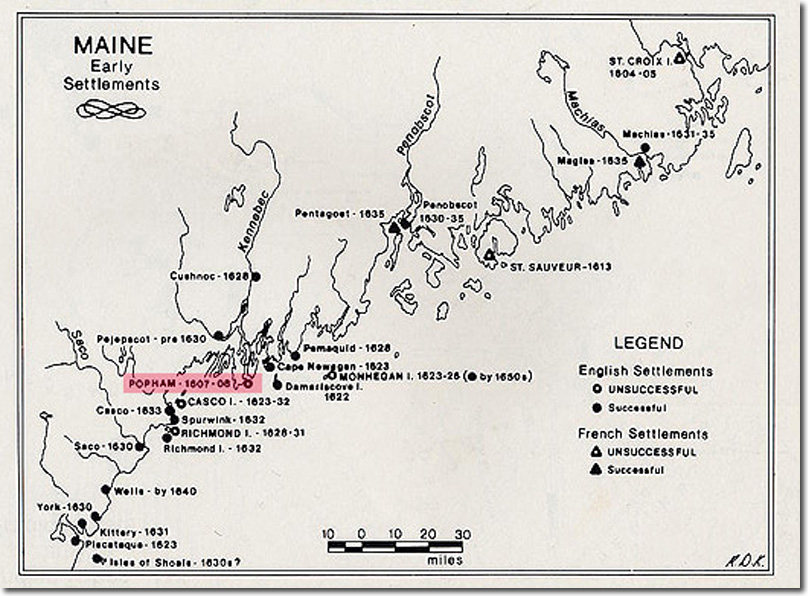This map below shows the early settlements, French and British, in the region now known as Maine. The Popham Colony in 1607 is highlighted in red. If you know anything about clothing for the outdoorsman then you know that Popham (Freeport) is the present day site of LLBean. James Davis had an eye for marketing apparently. James Davis and his brother Robert were each responsible for bringing the settlers from England to the Popham Colony in 1607. Popham and Jamestown were the second attempt made by the British to establish a settlement in the New World. The failed colony of Roanoke on the Carolina coastal Roanoke Island had vanished into the wilderness circa 1587. Davis constructed a fort at Popham, helped the colonist get settled in and returned to England for supplies.
The settlers grew miserable in his absence and some up and died of cold and starvation. Winters along the New England coast were far different than the British coast. Britain, warmed by the Gulf Stream was far milder than Maine, cooled by the Labrador Current off of the Arctic Sea. The surviving residents decided to take matters into their own hands and constructed the pinnace (ship), the Virginia of Sagadahoc. Davis returned within the year and piloted the settlers back home to England after one miserable winter. Matters had been compounded when news that the two benefactors, Popham and Gilbert, had each passed away during the year. Davis got the folks safely back to Britain and then made a return trip to the New World on the Virginia, as one ship of the nine in the Third Supply (1609) to Jamestown.
What we fail to teach in our American history classrooms is a point made graphically in this map. This map jumps out at me like a Jackson Pollock painting…. a lot of meaningless lines, dots and stuff. And then it becomes more of a DaVinci drawing. I realize the map maker is telling me a story. The Pilgrims weren’t the first to settle in here. Not by a long shot. Jamestown was not the first either. I look at this map with all these names of places and I realize the coast of Maine alone was littered with fishing villages. St. Croix 1604. It wasn’t successful. Like Popham it failed. But there was a lot of activity. So I dug into my history books and further north and east along this Atlantic coast line the French and British were heavily invested in fishing for the Cod, Tuna and Mackeral that swarmed in the teaming coasts of Nova Scotia and Newfoundland. This vessels had been putting into port for a few decades.
When our Pilgrim ancestors began digging around for places to plant crops they dug up the bones of white fishermen who had previously occupied the Plimouth shore. They found remnants of fishing equipment such as the drying racks upon which the fish were prepared for transport. They were told stories by the tribes of previous white guys who had been tooling around the coast in the forerunner of the bass boat, gathering up fish and staring at the world through a telescope. The tribes had already experienced all the wonders of colonial imperialism: theft, arson, larceny, rape, kidnapping and murder. No wonder they were suspicious of the Pilgrim. The Pilgrims discovered the tribal population had been depleted by a disease (Smallpox) that came as a curse brought by these white intruders. And the pilgrims learned all this from a Patuxet guy named Squanto (aka Tisquantum) who had an English education, because he had lived in England for 15 years as a captive of previous explorers. To learn more about our grand parents work with Tisquantum, please go to Ancestors in Plimouth Colony. A Smith grandparent, Stephen Hopkins, actually journeyed into the wilderness with Tisquantum, in order to arrange an alliance with the sachem of the First Nation.
Maps will enlarge if you click on them for better viewing. Use your back button to return to this page. For more information about the exploits of the Davis crew click on this link.



